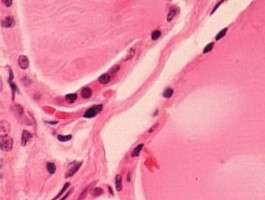
Initial findings from the Circulating Cell-free Genome Atlas (CCGA) study showed that prototypes sequencing assays tested in this analysis may facilitate the development of a highly specific blood test for early cancer detection, according to data presented at the AACR Annual Meeting 2018, April 14-18, in Chicago.
“The early results from our prototype assays suggest that it is feasible to design a comprehensive blood-based test that allows us to detect cancer in asymptomatic individuals,” said Alexander Aravanis, MD, PhD, vice president of research and development at GRAIL. “Our initial data suggest that it will be possible to develop a screening test for multiple cancers with very high specificity, potentially greater than 99 percent.”
Aravanis and colleagues utilized data from the CCGA study, a prospective, observational, longitudinal study at over 140 different sites around the United States that analyzes blood samples from participants with a recent cancer diagnosisand participants with no known cancer.
The researchers planto enroll 15,000 participants, noted Aravanis; the study has currently enrolled more than 10,000 individuals.
“Importantly, we designed the CCGA study to get a very representative cohort of individualsin the United States,” said Aravanis. “Additionally, we’re very careful not to exclude other pathologic conditions or diseases that we would ultimately encounter in a real-worldsetting.”
The researchers used blood samples from 878 participants with newlydiagnosed treatment-naïve cancer spanning 20 tumour types and across all clinical stages.
Additionally, 580 participants with no clinical cancer diagnosis were enrolled and 169 technical assay controls were utilized.
After isolating the cell-free DNA, samples were analyzed using three distinct sequencingmethods: targeted sequencing, to measure non-synonymous single nucleotide variants (SNVs) and indels in particular stretchesof the genome; whole-genome sequencing, to measure changes in copy number across the genome; and whole-genome bisulfite sequencing, to measure aberrant methylation patterns.
All three tests were performed from a single blood draw.
A “cancer-like” signal was found in less than one percent of participants who entered the study with no clinical diagnosis of cancer, suggesting the possibility of developing a test with a specificity higher than 99 percent.
Aravanis explained that a positive result in the few participants without a clinical diagnosis of cancer could be suggestive of undiagnosed cancer.
He also noted that additional data will be presented at the meeting showing that the prototype assays detected a strong biological signal in cancers that are typically unscreened.
Across all three assays tested, the strength of the signal increased with stage of disease.
Aravanis explained that DNA variants besides those generated by a cancerous tumour can also be present in the cell-free DNA, which could lead to a false-positive signal.
One source of these variants is clonal hematopoiesis, a common age-related process that results in variations in the DNA of the white blood cell (WBC) population.
Because a large fraction of the cell-free DNA comes from WBCs, Aravanis and colleagues also sequenced the paired WBCs during targeted and whole-genome sequencing.
In this way, they could subtract the signal generated from the WBCs to precisely focus on the tumour-related DNA variants.
The SNVs/indels from the WBC population accounted for 66 and 78 percent of all variants from the participants with and without cancer, respectively.
“This is an important scientific learning in the context of early cancer detection,” noted Aravanis. “We have the ability to identify these non-tumour derived DNA variants and remove them, resulting in a cleaner signal with results that are ultimately more specific.”
The researchers found an average of 1,2.4, and 6.5 nonsynonymous SNVs/indels per megabase in participants without cancer, with stage 1-3 cancer, and with stage 4 cancer, respectively.
Similarly, after whole-genome sequencing analysis, the researchers calculated a score of 0, 0.3, and 2 in participants without cancer, with stage 1-3 cancer, and with stage 4 cancer, respectively.
Finally, after whole-genome bisulfite sequencing analysis, the researchers calculated a methylation score of 0, 1, and 3.9 in participants without cancer, with stage 1-3 cancer, and with stage 4 cancer, respectively.
“From our prototype training assays, we found encouraging results that allowed us to detect the presence of cancer using three distinct methods with very few false positives,” said Aravanis. “Taken together, this is a good first step towards the ultimate development of a blood-based early cancer detection test.”
Aravanis noted that these data are from a training set, and the next step will be to verify these results in an independent validation set.
This study was sponsored by GRAIL, of which Aravanisis an employee and shareholder.
Source: AACR
The World Cancer Declaration recognises that to make major reductions in premature deaths, innovative education and training opportunities for healthcare workers in all disciplines of cancer control need to improve significantly.
ecancer plays a critical part in improving access to education for medical professionals.
Every day we help doctors, nurses, patients and their advocates to further their knowledge and improve the quality of care. Please make a donation to support our ongoing work.
Thank you for your support.